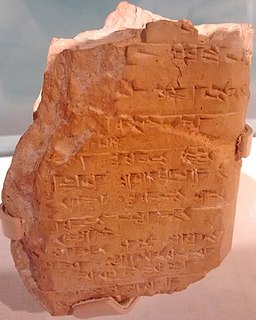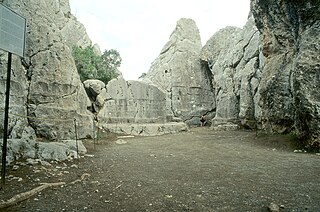
The Hittites were an Anatolian people who played an important role in establishing first a kingdom in Kussara, then the Kanesh or Nesha kingdom, and next an empire centered on Hattusa in north-central Anatolia. This empire reached its height during the mid-14th century BC under Šuppiluliuma I, when it encompassed an area that included most of Anatolia as well as parts of the northern Levant and Upper Mesopotamia.

Hittite, also known as Nesite, is an extinct Indo-European language that was spoken by the Hittites, a people of Bronze Age Anatolia who created an empire centred on Hattusa, as well as parts of the northern Levant and Upper Mesopotamia. The language, now long extinct, is attested in cuneiform, in records dating from the 17th to the 13th centuries BCE, with isolated Hittite loanwords and numerous personal names appearing in an Old Assyrian context from as early as the 20th century BCE, making it the earliest-attested use of the Indo-European languages.

Hattusa was the capital of the Hittite Empire in the late Bronze Age. Its ruins lie near modern Boğazkale, Turkey, within the great loop of the Kızılırmak River.
Hattusili I was a king of the Hittite Old Kingdom. He reigned ca. 1650–1620 BCE, or 1586–1556 BCE. Excavations in Zincirli Höyük, Southern Turkey, suggest that Hattusili I destroyed a complex at that site in the mid to late 17th century BCE, which can confirm the middle chronology dating for his reign. This event could have been part of his campaign against Zalpa in order to disrupt an exchange network connected to Aleppo that previously linked the Euphrates, North Syria, and Central Anatolia.

Yazılıkaya was a sanctuary of Hattusa, the capital city of the Hittite Empire, today in the Çorum Province, Turkey. Rock reliefs are a prominent aspect of Hittite art, and these are generally regarded as the most important group.

Hittite mythology and Hittite religion were the religious beliefs and practices of the Hittites, who created an empire centered in what is now Turkey from c. 1600–1180 BC.

Kussara (Kuššar) was a Middle Bronze Age kingdom in Anatolia. The kingdom, though apparently important at one time, is mostly remembered today as the origin of the dynasty that would form the Old Hittite Kingdom.

Alishar Hüyük was an ancient Near Eastern city. It is near the modern village of Alişar, Sorgun.
Kurunta was younger son of the early 13th century BC Hittite king Muwatalli II and cousin of Tudhaliya IV. Kurunta was thereby a Hittite prince and king of Tarhuntassa country. It has been suggested that he may have captured the Hittite capital for a very short time during the reign of the Hittite king Tuthaliya IV and declared himself a great king.
The Kaska were a loosely affiliated Bronze Age non-Indo-European tribal people, who spoke the unclassified Kaskian language and lived in mountainous East Pontic Anatolia, known from Hittite sources. They lived in the mountainous region between the core Hittite region in eastern Anatolia and the Black Sea, and are cited as the reason that the later Hittite Empire never extended northward to that area.

Sapinuwa was a Bronze Age Hittite city at the location of modern Ortaköy in the province Çorum in Turkey. It was one of the major Hittite religious and administrative centres, a military base and an occasional residence of several Hittite kings. The palace at Sapinuwa is discussed in several texts from Hattusa.

Nerik was a Bronze Age settlement to the north of the Hittite capitals Hattusa and Sapinuwa, probably in the Pontic region. Since 2005–2009, the site of Nerik has been identified as Oymaağaç Höyük, on the eastern side of the Kızılırmak River, 7 km (4.3 mi) northwest of Vezirköprü.

Šamuḫa is an ancient settlement near the village of Kayalı Pinar, c. 40 km west of Sivas, in the Sivas Province of Turkey. Located on the northern bank of Kizil Irmak river, it was a city of the Hittites, a religious centre and, for a few years, a military capital for the empire. Samuha's faith was syncretistic. Rene Lebrun in 1976 called Samuha the "religious foyer of the Hittite Empire".

Alacahöyük or Alaca Höyük is the site of a Neolithic and Hittite settlement and is an important archaeological site. It is situated in Alaca, Çorum Province, Turkey, northeast of Boğazkale, where the ancient capital city Hattusa of the Hittite Empire was situated. Its Hittite name is unknown: connections with Arinna, Tawiniya, and Zippalanda have all been suggested.

Kummuh was an Iron Age Neo-Hittite kingdom located on the west bank of the Upper Euphrates within the eastern loop of the river between Melid and Carchemish. Assyrian sources refer to both the land and its capital city by the same name. The city is identified with the classical-period Samosata, which has now been flooded under the waters of a newly built dam. Urartian sources refer to it as Kummaha. The name is also attested in at least one local royal inscription dating to the 8th century BCE. Other places that are mentioned in historical sources as lying within Kummuh are lands of Kištan and Halpi, and cities of Wita, Halpa, Parala, Sukiti and Sarita(?). Kummuh bordered the kingdoms of Melid to the north, Gurgum to the west and Carchemish to the south, while to the east it faced Assyria and later Urartu.
Zippalanda was a Hattic administrative and religious center of the Hittite Old Kingdom. Although its name was known from inscriptions, it was not until the latter 20th century that scholars placed it in Sorgun District of Yozgat Province, Turkey, near Kerkenes Dağ, about one day's journey north of Ankuwa. The plausible sites are the settlement mounds known as Çadır Mound and Uşaklı Mound.
Tegarama was a city in east-southeast Anatolia during the Bronze Age. It is often identified with Gürün and biblical Togarmah.

Hittite art was produced by the Hittite civilization in ancient Anatolia, in modern-day Turkey, and also stretching into Syria during the second millennium BCE from the nineteenth century up until the twelfth century BCE. This period falls under the Anatolian Bronze Age. It is characterized by a long tradition of canonized images and motifs rearranged, while still being recognizable, by artists to convey meaning to a largely illiterate population.
“Owing to the limited vocabulary of figural types [and motifs], invention for the Hittite artist usually was a matter of combining and manipulating the units to form more complex compositions"
Šinahuttum, later known as Sanahuitta, was a Bronze Age Assyrian city believed to have been northeast of Hattusa, the capital of the Hittite Empire in the late Bronze Age, near modern Boğazkale in Turkey. The city is mentioned in Assyrian sources 14 times and was noted for its donkey market and wool exchange.
Shuwala (Šuwala) was a Hurrian goddess who was regarded as the tutelary deity of Mardaman, a Hurrian city in the north of modern Iraq. She was also worshiped in other Hurrian centers, such as Nuzi and Alalakh, as well as in Ur in Mesopotamia, Hattusa in the Hittite Empire and in the Syrian cities Emar and Ugarit.













